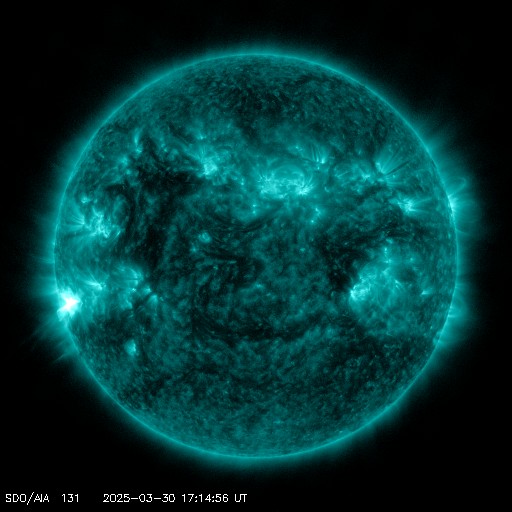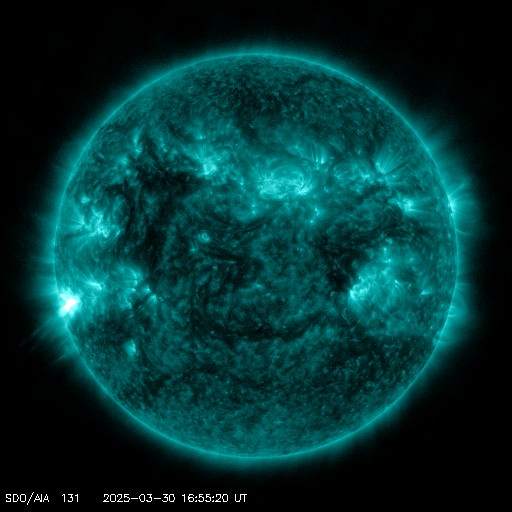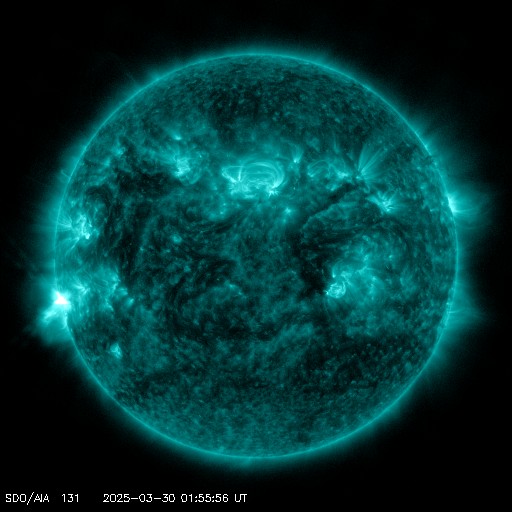Viewing archive of Wednesday, 23 April 2003
Solar activity report
Any mentioned solar flare in this report has a scaling factor applied by the Space Weather Prediction Center (SWPC). Because of the SWPC scaling factor, solar flares are reported as 42% smaller than for the science quality data. The scaling factor has been removed from our archived solar flare data to reflect the true physical units.
Report of Solar-Geophysical Activity 2003 Apr 23 2200 UTCPrepared by the NOAA © SWPC and processed by SpaceWeatherLive.com
Joint USAF/NOAA Report of Solar and Geophysical Activity
SDF Number 113 Issued at 2200Z on 23 Apr 2003IA. Analysis of Solar Active Regions and Activity from 22-2100Z to 23-2100Z
Solar activity increased to high levels this period.
Region 338 (N18W32) produced an M5/1n flare at 23/0106Z. Type II
(513 km/s) and Type IV radio sweeps, and a 380 sfu tenflare were
associated with this event. A partial halo CME was also detected on
LASCO imagery. An M2/1f flare also occurred in this region at
23/1556Z. This complex region continues to develop in both size and
magnetic complexity. Region 339 (N16W84) was quite active as it
approaches the west limb. It produced several C-class flares, the
largest being a C5 flare at 23/1213Z. No significant changes were
observed in the remaining active regions. New Region 343 (N06E60)
was numbered today.
IB. Solar Activity Forecast
Solar activity is expected to be at
moderate levels. Region 338 maintains potential for further M-class
activity.
IIA. Geophysical Activity Summary 22-2100Z to 23-2100Z
The geomagnetic field ranged from quiet to active levels with
isolated minor storm periods at high latitudes. Elevated solar wind
speeds near 500 km/s are responsible for the disturbed periods. The
greater than 2 MeV electrons at geosynchronous orbit reached high
levels again today.
IIB. Geophysical Activity Forecast
The geomagnetic field is
expected to be at unsettled to minor storm levels. Ongoing high
speed coronal hole flow will likely be enhanced by transient flow
over the next three days. Weak impact from the April 22, M2 flare
and CME are possible on day one. There is a higher probability for
CME impacts on days two and three from the M5 and associated CME
that occurred early this period.
III. Event Probabilities 24 Apr to 26 Apr
| Class M | 40% | 40% | 40% |
| Class X | 05% | 05% | 05% |
| Proton | 05% | 05% | 05% |
| PCAF | green | ||
IV. Penticton 10.7 cm Flux
Observed 23 Apr 133 Predicted 24 Apr-26 Apr 135/140/145 90 Day Mean 23 Apr 126
V. Geomagnetic A Indices
Observed Afr/Ap 22 Apr 013/022 Estimated Afr/Ap 23 Apr 015/020 Predicted Afr/Ap 24 Apr-26 Apr 020/020-020/020-015/015
VI. Geomagnetic Activity Probabilities 24 Apr to 26 Apr
| A. Middle Latitudes | |||
|---|---|---|---|
| Active | 30% | 40% | 30% |
| Minor storm | 20% | 30% | 20% |
| Major-severe storm | 05% | 10% | 05% |
| B. High Latitudes | |||
|---|---|---|---|
| Active | 40% | 50% | 40% |
| Minor storm | 30% | 35% | 30% |
| Major-severe storm | 10% | 15% | 10% |
All times in UTC
Current data suggests there is a slight possibility for aurora to appear at the following high latitude regions in the near future
Norilsk, VorkutaLatest news
Latest forum messages
More topicsSupport SpaceWeatherLive.com!
A lot of people come to SpaceWeatherLive to follow the Sun's activity or if there is aurora to be seen, but with more traffic comes higher server costs. Consider a donation if you enjoy SpaceWeatherLive so we can keep the website online!

Latest alerts
17:27 UTC - Solar flare
Moderate M1.5 flare
17:03 UTC - Solar flare
Moderate M1.61 flare
16:45 UTC - Radio Blackout
Minor R1 radio blackout in progress (≥M1 - current: M1.61)
02:09 UTC - Solar flare
Moderate M1.54 flare from sunspot region 4048
01:42 UTC - Radio Blackout
Minor R1 radio blackout in progress (≥M1 - current: M1.24)
Space weather facts
| Last X-flare | 2025/03/28 | X1.1 |
| Last M-flare | 2025/03/30 | M1.4 |
| Last geomagnetic storm | 2025/03/27 | Kp5 (G1) |
| Spotless days | |
|---|---|
| Last spotless day | 2022/06/08 |
| Monthly mean Sunspot Number | |
|---|---|
| February 2025 | 154.6 +17.6 |
| March 2025 | 127.5 -27.1 |
| Last 30 days | 127.5 -24.7 |





